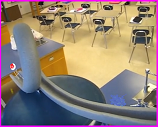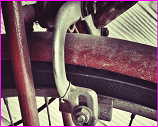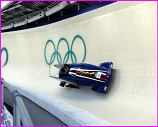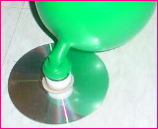Posted on May 15th, 2018 by Mary Lord
 Students in grades 7 to 9 build model roller coasters using pipe insulation and marbles, then analyze them using physics principles, including conversions between kinetic and potential energy and frictional effects. A class competition using various marbles to represent different passenger loads determines the most innovative and successful designs.
Students in grades 7 to 9 build model roller coasters using pipe insulation and marbles, then analyze them using physics principles, including conversions between kinetic and potential energy and frictional effects. A class competition using various marbles to represent different passenger loads determines the most innovative and successful designs.
Read More
Filed under: Class Activities, Grades 6-8, Grades 9-12, Lesson Plans | Comments Off on Building Roller Coasters
Tags: Class Activities, forces and motion, friction, Grades 6-8, Grades 9-12, Gravity, Lesson Plan, NASA education, Physics, rides, roller coasters, theme park
Posted on February 8th, 2018 by Mary Lord
 Students in grades 3 to 12 explore the effects of gravity, friction, and air resistance upon acceleration by using the engineering design process to design, build, and test their own bobsleds with the aim of reducing run times with each attempt.
Students in grades 3 to 12 explore the effects of gravity, friction, and air resistance upon acceleration by using the engineering design process to design, build, and test their own bobsleds with the aim of reducing run times with each attempt.
Read More
Filed under: Class Activities, Grades 6-8, Grades 9-12, Grades K-5 | Comments Off on Bobsled Blitz
Tags: 2018 winter Olympics, Aerodynamics, Bobsled, Class Activities, Engineering Design Process, forces and motion, friction, Grades 6-8, Grades 9-12, Grades K-5
Posted on May 20th, 2014 by Mary Lord
 In this activity, students in grades 3 to 6 learn about force and friction by examining how basic rim bicycle brakes work and discussing the advantages of various designs. They then use low cost materials to devise a simple braking system, suggest improvements to current bicycle brake designs, and present their recommended changes to the class.
In this activity, students in grades 3 to 6 learn about force and friction by examining how basic rim bicycle brakes work and discussing the advantages of various designs. They then use low cost materials to devise a simple braking system, suggest improvements to current bicycle brake designs, and present their recommended changes to the class.
Read More
Filed under: Class Activities, Grades 6-8, Grades 6-8, Grades K-5, Grades K-5 | Comments Off on Give Me a Brake!
Tags: bicycle, Class Activities, Design, Energy, Engineering Design, friction, gears, Grades 6-8, Grades K-5, Lesson Plan, motions and forces
Posted on January 20th, 2014 by Mary Lord
 Teams of students in grades 3 to 8 learn about friction, forces, and the engineering design process by building and testing miniature bobsleds to see which can race down an icy slope either the fastest or slowest.
Teams of students in grades 3 to 8 learn about friction, forces, and the engineering design process by building and testing miniature bobsleds to see which can race down an icy slope either the fastest or slowest.
Read More
Filed under: Class Activities, Grades 6-8, Grades 6-8, Grades K-5, Grades K-5, Lesson Plans | Comments Off on Build a Bobsled Racer
Tags: Aerodynamics, Bobsled, Boston Museum of Science, Energy, Engineering Design Process, friction, glide, kinetic energy, Olympics
Posted on July 3rd, 2011 by Mary Lord
 Understanding how friction works helps engineers design moving objects so they can be controlled. In this activity, students in grades 7 – 9 gain first-hand experience on how friction affects motion by building a hovercraft that uses air from a balloon to levitate a craft made from a compact disc (CD).
Understanding how friction works helps engineers design moving objects so they can be controlled. In this activity, students in grades 7 – 9 gain first-hand experience on how friction affects motion by building a hovercraft that uses air from a balloon to levitate a craft made from a compact disc (CD).
Read More
Filed under: Grades 6-8, Lesson Plans | Comments Off on Lesson: Hovercraft Racers
Tags: Class Activities, friction, hovercraft, Lesson Plan, Physics
Posted on December 1st, 2008 by ASEE
In this activity, late-elementary school students work in small groups to build a roller coaster with at least one loop and one jump, demonstrating how potential energy transforms into kinetic energy. Students observe the relationship of height to potential energy and the resulting kinetic energy.
Read More
Filed under: Class Activities, Grades K-5 | Comments Off on Class Activity: Build a Roller Coaster
Tags: Class Activities, forces and motion, friction, Grades 3-6, Grades K-5, kinetic energy, Mechanical engineering, roller coaster
 Students in grades 7 to 9 build model roller coasters using pipe insulation and marbles, then analyze them using physics principles, including conversions between kinetic and potential energy and frictional effects. A class competition using various marbles to represent different passenger loads determines the most innovative and successful designs.
Students in grades 7 to 9 build model roller coasters using pipe insulation and marbles, then analyze them using physics principles, including conversions between kinetic and potential energy and frictional effects. A class competition using various marbles to represent different passenger loads determines the most innovative and successful designs.








 Students in grades 3 to 12 explore the effects of gravity, friction, and air resistance upon acceleration by using the engineering design process to design, build, and test their own bobsleds with the aim of reducing run times with each attempt.
Students in grades 3 to 12 explore the effects of gravity, friction, and air resistance upon acceleration by using the engineering design process to design, build, and test their own bobsleds with the aim of reducing run times with each attempt. In this activity, students in grades 3 to 6 learn about force and friction by examining how basic rim bicycle brakes work and discussing the advantages of various designs. They then use low cost materials to devise a simple braking system, suggest improvements to current bicycle brake designs, and present their recommended changes to the class.
In this activity, students in grades 3 to 6 learn about force and friction by examining how basic rim bicycle brakes work and discussing the advantages of various designs. They then use low cost materials to devise a simple braking system, suggest improvements to current bicycle brake designs, and present their recommended changes to the class. Teams of students in grades 3 to 8 learn about friction, forces, and the engineering design process by building and testing miniature bobsleds to see which can race down an icy slope either the fastest or slowest.
Teams of students in grades 3 to 8 learn about friction, forces, and the engineering design process by building and testing miniature bobsleds to see which can race down an icy slope either the fastest or slowest. Understanding how friction works helps engineers design moving objects so they can be controlled. In this activity, students in grades 7 – 9 gain first-hand experience on how friction affects motion by building a hovercraft that uses air from a balloon to levitate a craft made from a compact disc (CD).
Understanding how friction works helps engineers design moving objects so they can be controlled. In this activity, students in grades 7 – 9 gain first-hand experience on how friction affects motion by building a hovercraft that uses air from a balloon to levitate a craft made from a compact disc (CD).